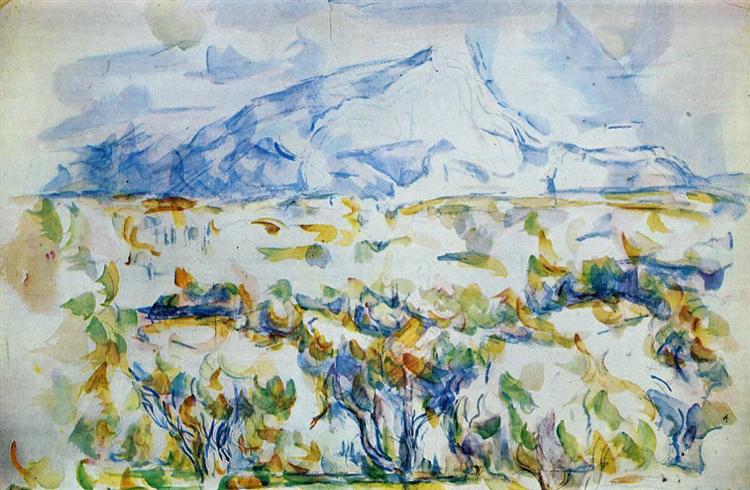Descrizione
Paul Cézanne, una figura fondamentale del post-impressionismo, in particolare nel suo lavoro "Mont Sainte-Victoire" del 1903, si allontana dalla semplice rappresentazione naturalistica per esplorare le interazioni tra forma e colore, che gli dà una dimensione astratta e allo stesso modo tempo profondamente emotivo per il paesaggio provenzale. In questo dipinto, il Monte Sainte-Victoire diventa non solo un monumento geografico, ma anche artistico, affermando una presenza monumentale nella composizione.
La scena è costruita attorno a un'economia di forme che tocca la semplicità; La montagna, con la sua silhouette definita e le sue morbide inclinazioni, si trova sul fondo, dominando il paesaggio. Cézanne usa strati di colore in una tavolozza prevalentemente di toni blu e verdi, con accenti in ocra e giallo che evocano la ricchezza della natura provenzale. La tecnica di pennellate corte e intrecciate, caratteristiche dell'artista, dà una consistenza vibrante al dipinto, dando vita alla superficie e suggerendo l'atmosfera luminosa che circonda la montagna.
Una delle caratteristiche più intriganti di questo lavoro è il modo in cui Cézanne concepisce lo spazio. Invece della tradizionale prospettiva lineare, il pittore mostra una prospettiva ACONCAVA che consente allo spettatore di sperimentare il paesaggio in un tocco quasi. La forma della montagna sembra non solo essere fortemente ancorata nel paesaggio, ma anche intrinsecamente correlata alla vegetazione e alle colline che la circonda, come se l'intero ambiente fosse in un dialogo continuo. Questa concezione dello spazio anticipa il cubismo, sottolineando l'idea che molteplici prospettive possano coesistere su un unico piano.
Sebbene i personaggi umani non appaiano esplicitamente nella pittura, l'impronta dell'attività umana è suggerita attraverso i piccoli percorsi tortuosi che attraversano lo sfondo e le foreste disposte nella composizione. Questi elementi suggeriscono l'interazione dell'uomo con la natura, suggerendo un discorso sul paesaggio che va oltre la semplice rappresentazione di un luogo ideale. Questa relazione tra lo spettatore, il paesaggio e l'umano è presente in molte opere di Cézanne, che cerca di dare vita a uno spazio che risuona con l'esperienza emotiva dell'essere umano.
La creazione di "Mont Sainte-Victoire" coincide con un periodo cruciale nella carriera di Cézanne, in cui viene stabilito un profondo dialogo con elementi visivi, esplorando come la natura può, attraverso la pittura, essere interpretata oltre la sua rappresentazione letterale. È interessante notare che questo lavoro è uno dei vari approcci che l'artista ha fatto sulla montagna per tutta la vita, essendo un tema ricorrente che Cézanne ha reinterpretato in più occasioni, sottolineando la sua rilevanza nel suo lavoro.
Il Monte Sainte-Victoire, mentre Cézanne lo ha fiattimato, non è solo un paesaggio, ma come un simbolo duraturo della lotta per comprendere la natura attraverso l'arte. Questo pezzo, con la sua audace sperimentazione nella forma e nel colore, invita lo spettatore a partecipare a un viaggio visivo ed emotivo che trascende il semplice atto di contemplare. L'opera è una volontà dell'evoluzione della pittura moderna e del ruolo fondamentale che Cézanne ha svolto nel suo sviluppo. Pertanto, "Mont Sainte-Victoire" non solo ribadisce la montagna come pietra miliare geografica, ma anche come un pilastro della ricerca artistica verso nuove dimensioni della percezione visiva.
KUADROS ©, una famosa vernice sul muro.
Dipinti ad olio fatti a mano, con la qualità degli artisti professionisti e il distintivo sigillo di KUADROS ©.
Servizio di riproduzione delle immagini con garanzia di soddisfazione. Se non sei completamente soddisfatto della replica del tuo dipinto, rimborsiamo i tuoi soldi al 100%.

